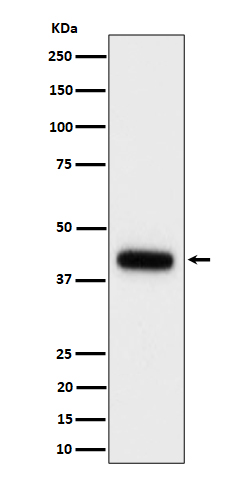Clusterin Rabbit mAb [L5z1]Cat NO.: A97100
Western blot(SDS PAGE) analysis of extracts from mouse serum cell lysate.Using Clusterin Rabbit mAb [L5z1]at dilution of 1:1000 incubated at 4℃ over night.
Product information
Protein names :AAG4; Aging-associated gene 4 protein; APOJ; ApoJalpha; ApoJbeta; Apolipoprotein J; CLI; CLU; Clusterin alpha chain; Clusterin; Complement cytolysis inhibitor a chain; Complement cytolysis inhibitor; Complement cytolysis inhibitor b chain; complement lysis inhibitor;Ku70-binding protein 1; KUB1; NA1/NA2; SGP2; sulfated glycoprotein 2; Testosterone-repressed prostate message 2;TRPM2;
UniProtID :Q06890(mouse)
MASS(da) :51,656
MW(kDa) :40kDa
Form :Liquid
Purification :Affinity-chromatography
Host :Rabbit
Isotype : IgG
sensitivity :Endogenous
Reactivity :Mouse Rat
- ApplicationDilution
- 免疫印迹(WB)1:1000-2000
- 免疫组化(IHC)1:100
- The optimal dilutions should be determined by the end user
Specificity :Antibody is produced by immunizing animals with A synthesized peptide derived from human Clusterin
Storage :Antibody store in 10 mM PBS, 0.5mg/ml BSA, 50% glycerol. Shipped at 4°C. Store at-20°C or -80°C. Products are valid for one natural year of receipt.Avoid repeated freeze / thaw cycles.
WB Positive detected :mouse serum cell lysate.
Function : Functions as extracellular chaperone that prevents aggregation of non native proteins. Prevents stress-induced aggregation of blood plasma proteins (By similarity). Inhibits formation of amyloid fibrils by APP, APOC2, B2M, CALCA, CSN3, SNCA and aggregation-prone LYZ variants (in vitro) (PubMed:14741101). Does not require ATP. Maintains partially unfolded proteins in a state appropriate for subsequent refolding by other chaperones, such as HSPA8/HSC70. Does not refold proteins by itself. Binding to cell surface receptors triggers internalization of the chaperone-client complex and subsequent lysosomal or proteasomal degradation. When secreted, protects cells against apoptosis and against cytolysis by complement. Intracellular forms interact with ubiquitin and SCF (SKP1-CUL1-F-box protein) E3 ubiquitin-protein ligase complexes and promote the ubiquitination and subsequent proteasomal degradation of target proteins. Promotes proteasomal degradation of COMMD1 and IKBKB. Modulates NF-kappa-B transcriptional activity (By similarity). Following stress, promotes apoptosis (PubMed:12551933). Inhibits apoptosis when associated with the mitochondrial membrane by interference with BAX-dependent release of cytochrome c into the cytoplasm. Plays a role in the regulation of cell proliferation. Following ER stress, suppresses stress-induced apoptosis by stabilizing mitochondrial membrane integrity through interaction with HSPA5. When secreted, does not affect caspase or BAX-mediated intrinsic apoptosis and TNF-induced NF-kappa-B-activity (By similarity). When secreted, acts as an important modulator during neuronal differentiation through interaction with STMN3 (By similarity). Plays a role in the clearance of immune complexes that arise during cell injury (PubMed:11865066)..
Tissue specificity :Most abundant in stomach, liver, brain, and testis, with intermediate levels in heart, ovary and kidney.
Subcellular locationi :Secreted. Nucleus. Cytoplasm. Mitochondrion membrane,Peripheral membrane protein,Cytoplasmic side. Cytoplasm, cytosol. Microsome. Endoplasmic reticulum. Mitochondrion. Mitochondrion membrane. Cytoplasm, perinuclear region. Cytoplasmic vesicle, secretory vesicle, chromaffin granule.
IMPORTANT: For western blots, incubate membrane with diluted primary antibody in 1% w/v BSA, 1X TBST at 4°C overnight.


